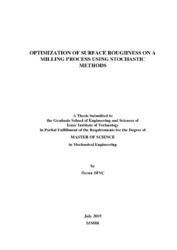Please use this identifier to cite or link to this item:
https://hdl.handle.net/11147/7355Full metadata record
| DC Field | Value | Language |
|---|---|---|
| dc.contributor.advisor | Artem, Hatice Seçil | |
| dc.contributor.author | Dinç, Özcan | - |
| dc.date.accessioned | 2019-11-13T12:40:48Z | |
| dc.date.available | 2019-11-13T12:40:48Z | |
| dc.date.issued | 2019-07 | en_US |
| dc.identifier.citation | Dinç, Ö. (2019). Optimization of surface roughness on a milling process using stochastic methods. Unpublished master's thesis, İzmir Institute of Technology, İzmir, Turkey | en_US |
| dc.identifier.uri | https://hdl.handle.net/11147/7355 | |
| dc.description | Thesis (Master)--Izmir Institute of Technology, Mechanical Engineering, Izmir, 2019 | en_US |
| dc.description | Includes bibliographical references (leaves: 51-53) | en_US |
| dc.description | Text in English; Abstract: Turkish and English | en_US |
| dc.description.abstract | Nowadays, milling process is one of the most widely used metal processing methods in many fields from space and aircraft to automotive industry. The surface roughness values of the workpiece in milling process vary depending on the thermal, chemical and abrasive loads that occur during cutting. Spindle speed, depth of cut and feed rate are the cutting parameters affecting the surface roughness. Hence, these parameters at the time of machining constitute an important issue. Accordingly, in this thesis optimization of surface roughness has been performed using the stochastic search methods. First, using experimental data obtained in the milling process, it was aimed to establish a regression model to determine average surface roughness equation as an objective function. The cutting parameters and average surface roughness value were considered as input and output in regression analysis, respectively. In this study, seven different mathematical models have been established and examined to carry out regression analysis. The reliability and stability of the mathematical models were investigated. The most appropriate mathematical model has been constructed and then used as an objective function for optimization. Nelder-Mead, Random-Search, Simulated Annealing, and Differential Evolution were the stochastic search algorithms to perform the optimization in the present study. In conclusion, it was found that the minimum average surface roughness value depends on spindle speed, depth of cut and feed parameters. | en_US |
| dc.description.abstract | Günümüzde metal işleme yöntemlerinden biri olan frezeleme işlemi uzay ve uçak sanayinden otomotiv sanayisine kadar bir çok alanda yaygın olarak kullanılmaktadır. İş parçasının yüzey pürüzlülük değerleri kesme anında oluşan termal, kimyasal ve aşındırıcı yüklere bağlı olarak değişmektedir. İş mili hızı, kesme derinliği ve ilerleme, yüzey pürüzlülüğünü etkileyen kesme parametreleridir. Bu nedenle, işleme anındaki bu parametreler önemli bir konudur. Buna göre, bu tezde yüzey pürüzlülüğü optimizasyonu stokastik arama yöntemleri kullanılarak yapılmıştır. İlk olarak, frezeleme işleminde elde edilen deneysel verileri kullanarak, ortalama yüzey pürüzlülüğü denklemini amaç fonksiyonu olarak belirlemek için bir regresyon modelin oluşturulması amaçlanmıştır. Kesme parametreleri ve ortalama yüzey pürüzlülüğü değeri, optimizasyon analizinde sırasıyla girdi ve çıktı olarak kabul edildi. Bu çalışmada, regresyon analizi yapmak için yedi farklı matematiksel model kurulmuş ve incelenmiştir. Matematiksel modellerin güvenilirliği ve kararlılığı araştırılmıştır. En uygun matematiksel model inşa edilmiş ve sonra optimizasyon için amaç fonksiyonu olarak kullanılmıştır. Nelder-Mead, Random- Search, Simulated Annealing ve Differential Evolution bu çalışmada optimizasyonu gerçekleştirmek için kullanılan stokastik arama algoritmalarıdır. Sonuç olarak, minimum ortalama yüzey pürüzlülük değerinin iş mili hızına, kesme derinliğine ve ilerleme parametrelerine bağlı olduğu bulunmuştur. | en_US |
| dc.format.extent | ix, 53 leaves | en_US |
| dc.language.iso | en | en_US |
| dc.publisher | Izmir Institute of Technology | en_US |
| dc.rights | info:eu-repo/semantics/openAccess | en_US |
| dc.subject | Milling process | en_US |
| dc.subject | Surface roughness | en_US |
| dc.subject | Cutting parameters | en_US |
| dc.title | Optimization of surface roughness on a milling process using stochastic methods | en_US |
| dc.title.alternative | Stokastik yöntemler kullanarak frezeleme işleminde yüzey pürüzlülüğü optimizasyonu | en_US |
| dc.type | Master Thesis | en_US |
| dc.institutionauthor | Dinç, Özcan | - |
| dc.department | Thesis (Master)--İzmir Institute of Technology, Mechanical Engineering | en_US |
| dc.relation.publicationcategory | Tez | en_US |
| item.languageiso639-1 | en | - |
| item.fulltext | With Fulltext | - |
| item.openairecristype | http://purl.org/coar/resource_type/c_18cf | - |
| item.openairetype | Master Thesis | - |
| item.grantfulltext | open | - |
| item.cerifentitytype | Publications | - |
| Appears in Collections: | Master Degree / Yüksek Lisans Tezleri | |
Files in This Item:
| File | Description | Size | Format | |
|---|---|---|---|---|
| T002023.pdf | MasterThesis | 986.34 kB | Adobe PDF |  View/Open |
CORE Recommender
Page view(s)
84
checked on Jul 22, 2024
Download(s)
608
checked on Jul 22, 2024
Google ScholarTM
Check
Items in GCRIS Repository are protected by copyright, with all rights reserved, unless otherwise indicated.